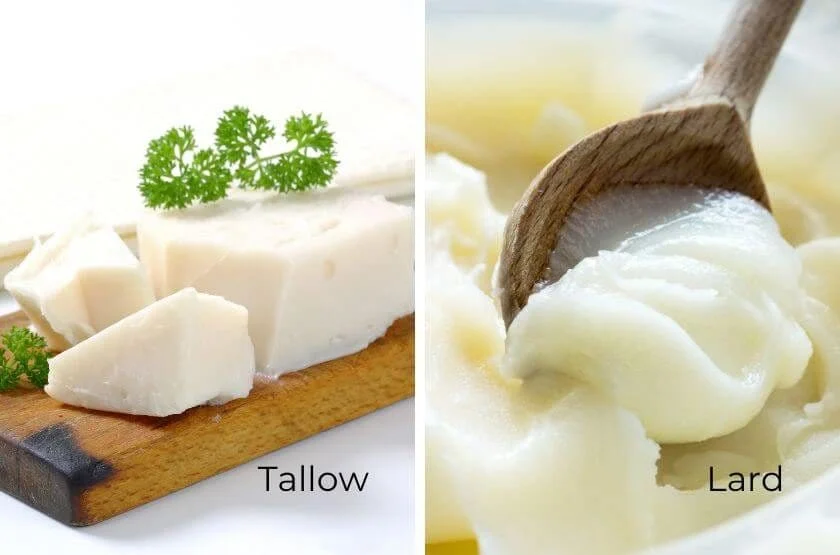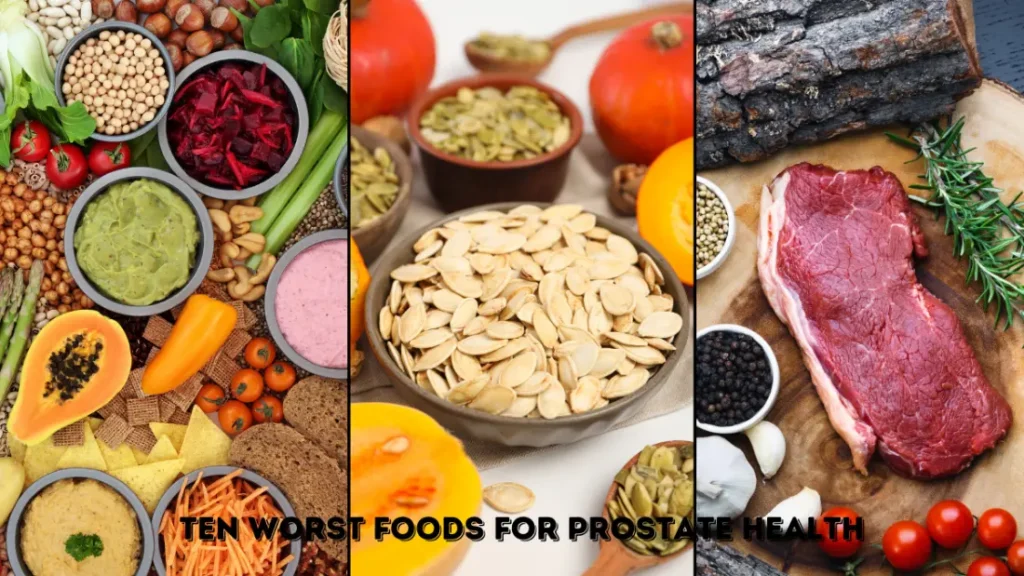How to make tallow and why? Making beef tallow at home is a great way to use up extra fat trimmings from brisket or other cuts of beef. It’s a delicious alternative to oil or butter and adds amazing flavor to dishes. The process is simple, and I’ll guide you with every single step to show you how to make tallow (beef tallow) in your kitchen.
What is Tallow?
Tallow is the solidified fat from cows or sheep. It has a waxy texture, similar to butter or coconut oil, and stays stable at room temperature.
When stored in an airtight container, beef tallow can last for months without spoiling. Thanks to its high smoke point and mild taste, it’s great for cooking methods like deep-frying or sautéing.
Before the mid-1900s, tallow was a common cooking fat in homes, but vegetable oils like canola and olive oil eventually became more popular. Besides cooking, tallow was also widely used in making soap and skincare products.
Lard and suet are similar to tallow. However, lard comes from pork fat, while suet is the fat found around the liver and heart of cows, lambs, or sheep.
The History of Tallow
A long time ago, animal fats were common in most kitchens. Beef tallow and lard (rendered pork fat) were especially popular.
But in the early 20th century, a new vegetable shortening appeared, and soon after, people became afraid of cholesterol.
As a result, animal fats lost their popularity. Thankfully, in recent years, tallow and lard have made a comeback, thanks to the rise of paleo and keto diets.
What Is the Nutritional Information for Tallow?
People who want to learn how to make tallow also wonder about its nutritional value. Beef tallow has no carbs, making it a good option for low-carb or keto diets. For a healthier choice, use grass-fed beef tallow, which is more natural and organic. One tablespoon of beef tallow has 115 calories, 13 grams of fat, about 6.5 grams of saturated fat, and 14 milligrams of cholesterol.
It has no dietary fiber, sugar, or protein. Tallow also provides small amounts of important nutrients like vitamins D and E, conjugated linoleic acid (CLA), stearic acid, and omega-3 fatty acids, all of which are good for your skin.
Tools for Making Beef Tallow

Before learning how to make tallow, you must have the given tools. Although creating a beef tallow is not challenging, there are a few supplies and equipment that you ought to have on hand to get that beautiful, silky finished result. Some of the items you will need to gather before making the tallow I have already mentioned.
- Stock Pot: In a stock pot or what you can call broth, the fat reduces, therefore I suggest using a larger pot than you anticipate needing. I assure you that you do not want any fat to splatter across your stovetop or surfaces.
- Fine Strainer: Ensure that you have a fine-mesh strainer available so you can remove any large meat chunks and other contaminants that don’t boil down with the fat.
- Funnel: For the last squeezing into the storing jar, a tube is needed. Here, any funnel can be used.
- Cotton Cheesecloth: The ideal substrate for the final filtering is cheesecloth, although paper towels or coffee filters will work as well if you don’t have any on board.
- Mason Jars: To store your tallow, a wide-mouth mason container works well. The tallow will keep well in the refrigerator and is easy to put in and remove from the broad opening.
How to make tallow (Beef Tallow)
Finally let’s learn how to make tallow, the beef tallow. Follow the instructions.
- Place all your beef fat in a large 4-5 quart pot. Set the burner to medium-low heat.
- Let the fat slowly simmer for about 4 hours, stirring every 30 minutes with a wooden spatula. Scrape the spatula along the bottom of the pot to prevent any fat or beef bits from sticking and burning. Keep the heat low to avoid boiling—just maintain a gentle simmer.
- You’ll know the tallow is done when most of the fat has melted, and the remaining pieces in the pan are lightly browned and crispy. There shouldn’t be any more white or solid fat left.
- Turn off the heat and let the tallow cool a bit. Use the strainer to catch any crispy beef pieces.
- To filter the tallow even more, fit a funnel with cheesecloth, a coffee filter, or a paper towel, and pour the tallow from the bowl through the funnel into a glass jar.
- The tallow is now ready to use. You can store it in the fridge with a tight-fitting lid for up to 3 months. Use it to cook potatoes, sear steaks, or roast vegetables instead of other fats.
Beef Tallow Recipes
Try these dishes to see if you have learned how to make tallow very well and use it in your baking. You can substitute beef tallow for butter or oil in recipes that don’t particularly call for it.
- Skillet Potatoes. The potatoes in the following dish are cooked in beef tallow, and they’re the finest potatoes you’ve ever had, I promise.
- Seared Steak. To add even more flavor to your delicious reverse-seared steak, consider searing it in some tallow!
- Cornbread. In most dishes, you may use this beef tallow instead of butter. For an incredible flavor, try making this dish without the butter.
Tallow vs Lard

People wanting to know how to make tallow often ask me about the difference between tallow and lard. Both have high smoke points, like vegetable oil, but there are some key differences to know.
Tallow comes from the cooked, rendered fat of animals like beef, bison, goat, lamb, or venison (basically, ruminants). Lard, on the other hand, is always made from pork fat. One big difference is how they behave when cooled. Tallow solidifies quickly and can feel sticky, almost like Chapstick, if the food isn’t served hot. Lard, however, stays softer due to its lower melting point. Even when refrigerated, it’s spreadable, similar to butter.
This makes lard better for all-purpose cooking, and it won’t leave that sticky texture in your mouth if the food cools down.
If you want more articles to read:
- Make The Rich & Comforting Chicken And Sausage Gumbo
- Why Visit Angers In France? 5 Wonderful Reasons
- How to Make Hot Pot at Home Easily & Love It
5 Uses of Tallow
Now that you’ve learned how to make tallow, you should know about its historical uses as well. Here are several historical uses for beef tallow, some of which are still in use today even though it is no longer used in most modern businesses.
Cooking Oil
One reason beef tallow is so popular as a cooking oil is its high melting point. Vegetable oils are more fragile when burned because of their increased polyunsaturated fat level; instead, use beef tallow.
Beef tallow works well for pan-searing your preferred meat or deep-frying fries and vegetables. It is also a main ingredient in pemmican, a Native North American delicacy composed of berries, tallow, and frozen meat.
Lubricant & Biodiesel Fuel
Tallow works well as a last-resort lubricant for leather, wood, and metal products. Tallow was used as a standard lubricant for locomotives on ships and trains until the 1950s.
One of the primary components of biodiesel fuel, which is derived from vegetable or animal fats and burns cleanly, is tallow.
Skincare & Soap Making
Because tallow balm is quickly absorbed by the skin and has anti-inflammatory qualities, it was previously a common type of moisturizer for the skin. Tallow is not used by contemporary skincare brands for several reasons, including contaminants and the fact that it is not made without cruelty.
Although tallow soap recipes from nearly 5,000 years ago can still be found, modern soap manufacturers now employ synthetic components in place of tallow.
How To Store
Store homemade beef tallow in an airtight container in a cool, dark place to make it last as long as possible. For even longer storage, refrigerate or freeze it. When kept in the fridge, it can last up to a year, and in the freezer, it can stay good for up to two years.
Vacuum-sealing the tallow will extend its shelf life even further. To store tallow long-term, pour the melted tallow into silicone loaf molds.
Once it hardens, vacuum-seal the tallow blocks and freeze them for easy, long-lasting storage.
Frequently Asked Questions (FAQs)
When learning how to make tallow, people often ask the following queries.
Why Make Tallow at Home
Most people ask how to make tallow at home while some people also ask why make it at home. That one is simple! Because all of the beef scraps you cook can be used to generate liquid gold! I made use of the fat that was going to be thrown out. Of course, you can always purchase it by the can if you don’t have any fat on hand or simply don’t feel like doing the labor!
Is Beef Tallow the Same as Beef Fat?
Both yes and no. Render-specified cow fat is known as beef tallow. As heated, it is a liquid, but as it cools, it hardens and stays solid even at room temperature. However, the good thing persists after the terrible stuff is removed. Hence, even if beef fat is used to make beef tallow, the two are unquestionably different in terms of taste and health.
Is Tallow Healthy?
Protein or carbs are absent from beef tallow, which is only pure saturated fat. It is regarded as a source of vitamins D and E and has trace quantities of selenium. It aids in the ingestion of fat-soluble vitamins due to its proportion of fat.







